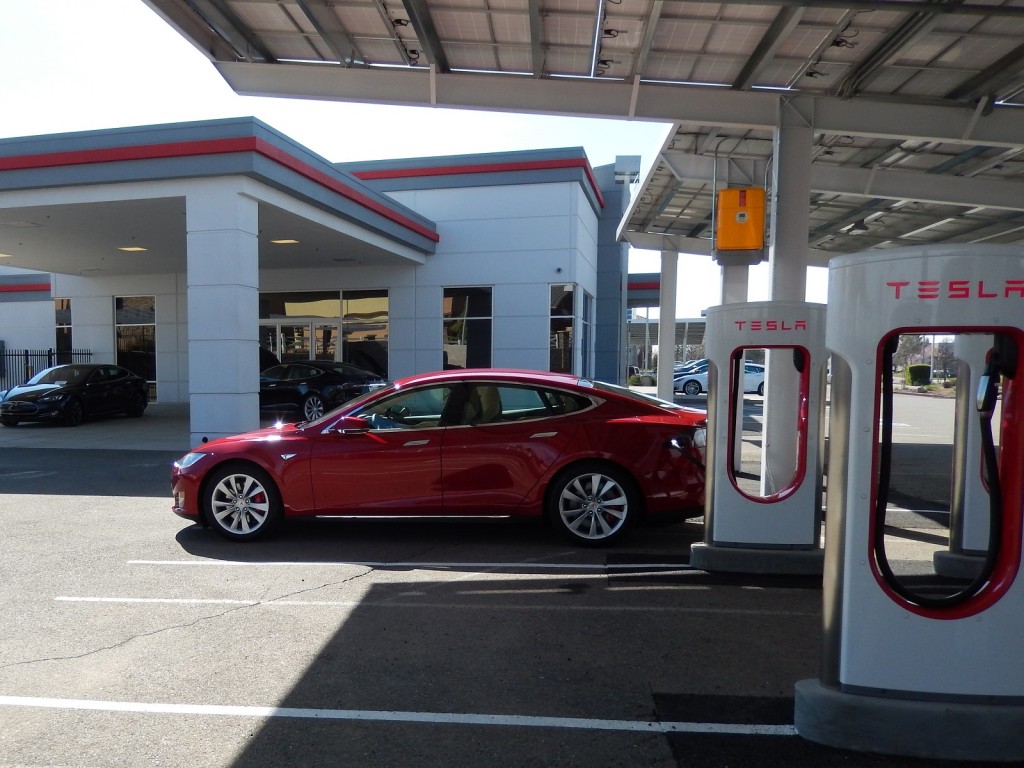Since launching the Supercharger DC fast-charging in 2012, Tesla Motors has steadily worked to increase the number of stations across the world.
But in a few cases, the existing network may no longer be able to keep up with demand from concentrations among the tens of thousands of Tesla Model S cars sold in the U.S.
The recent holiday season--and the increased traffic it brought--lead to significant congestion at certain Supercharger sites, according to reports from analysts and Tesla owners.
DON'T MISS: Tesla Letter To Rein In Local Supercharger Use Goes Wrong
Congestion is likely to only get worse as Tesla looks to increase sales, and launch the higher-volume Model 3 electric car, notes financial site Seeking Alpha.
Things were particularly bad the day after Christmas at the Tejon Ranch Supercharger site in Lebec, California.
As many as 15 cars queued up at a time, and drivers waited up to two hours for a charge, according to posts on the Tesla Motors Club forum.
![Tesla Model S at Supercharger site in Ventura, CA, with just one slot open [photo: David Noland] Tesla Model S at Supercharger site in Ventura, CA, with just one slot open [photo: David Noland]](https://images.hgmsites.net/lrg/tesla-model-s-electric-car-road-trip-upstate-new-york-to-southern-california-photo-david-noland_100500011_l.jpg)
Tesla Model S at Supercharger site in Ventura, CA, with just one slot open [photo: David Noland]
The Tejon Ranch Supercharger is one of 37 operational Supercharger sites in California, which has the most sites of any state.
While congestion of the magnitude witnessed at Tejon Ranch is unusual, Tesla has seems to be at least somewhat concerned about it becoming more of a recurring problem.
Last summer, it sent a letter to owners asking them to curtail Supercharger use for local driving, so that drivers on longer trips could more easily access stations.
MORE: Elon Musk: Tesla Model S 'Ends Range Anxiety' With Smart Navigation, Trip Planner
However, the suggestion was met with hostility by owners.
Before that, Tesla also launched a navigation update meant to quell range anxiety.
It included a "Range Assurance" feature that constantly checks whether a car has enough charge to reach its destination, and a trip planner that selects a route based on charging-station locations.

2015 Tesla Model S P85D Supercharging in Rocklin, California, Feb 2015
At the time, Tesla CEO Elon Musk proclaimed these features would "end range anxiety," although their real-world impact is likely somewhat less definitive.
In addition, Tesla has quietly augmented its network of DC Supercharger stations with slower Level 2 AC stations--which it refers to as "destination chargers."
These are placed at locations where cars are likely to remain stationary for long periods of time--such as parking garages and hotels--minimizing the inconvenience of longer charging times.
But Tesla may have to do even more to keep up with demand.
![Solar panels at Supercharger in Barstow, CA, during Tesla Model S road trip [photo: David Noland] Solar panels at Supercharger in Barstow, CA, during Tesla Model S road trip [photo: David Noland]](https://images.hgmsites.net/lrg/tesla-model-s-electric-car-road-trip-upstate-new-york-to-southern-california-photo-david-noland_100500010_l.jpg)
Solar panels at Supercharger in Barstow, CA, during Tesla Model S road trip [photo: David Noland]
The Silicon Valley automaker delivered just about 50,000 cars in in 2015, but says it hopes to deliver 500,000 cars per year by 2020.
Deliveries are expected to increase dramatically with the introduction of the Model 3, projected for 2017.
That car will have a 200-mile range and a base price of $35,000 before incentives--half that of the cheapest current Model S.
_______________________________________________












